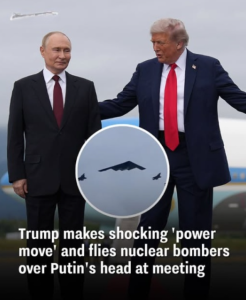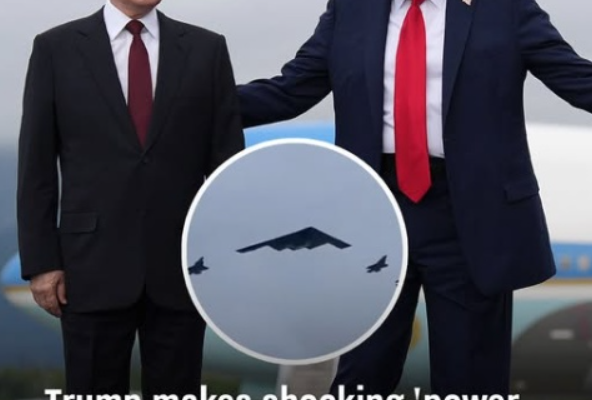Trump’s Alaska Flyover: A Nuclear-Capable Flex Like No Other
On August 15, 2025, Anchorage, Alaska, became the stage for one of the most symbolic acts of military posturing in recent memory. As former U.S. President Donald Trump stepped onto the tarmac to meet Russian President Vladimir Putin, the skies above were split by the unmistakable silhouette of a B-2 Spirit stealth bomber, flanked by four cutting-edge F-35 Lightning II fighter jets.
The move was dramatic enough to dominate headlines—UNILAD called it a “shocking ‘power move’”—but what really made this flyover unique wasn’t just the timing or location. It was the fact that the B-2 Spirit is a one-of-a-kind aircraft owned and operated solely by the United States. No other military on Earth possesses it.
The B-2 Spirit: America’s Exclusive Flying Shadow
The B-2 Spirit isn’t just another bomber—it’s a strategic, nuclear-capable stealth aircraft that represents the apex of American aerospace engineering.
-
First Flight: 1989
-
Cost per Unit: Roughly $2.1 billion (including research and development)
-
Current Fleet: Around 20 operational units, all based at Whiteman Air Force Base in Missouri.
-
Stealth Capability: Its radar-evading design allows it to penetrate sophisticated enemy air defenses undetected.
-
Payload: Can carry up to 40,000 pounds of weapons, including nuclear warheads.
The reason no other country has a B-2 isn’t just about money—it’s about decades of classified research, materials science, and stealth technology that the U.S. has kept closely guarded. The aircraft’s shape, coating materials, and radar-absorbent composites are among the most closely held secrets in the Pentagon.
Why the Flyover Was Such a Big Deal
When you combine this exclusivity with the context of the moment, the symbolism becomes sharp.
-
Aimed Message to Putin – Even if the official story is that the flyover was “routine” or scheduled by the Air Force, the optics were unavoidable: a nuclear-capable, radar-invisible bomber flew directly over a Russian leader’s head during a tense U.S.–Russia meeting.
-
Psychological Pressure – Military power isn’t just about weaponry—it’s about perception. Seeing the world’s only bomber capable of slipping into Russian airspace undetected sends a psychological message: We can reach anywhere, anytime.
-
American Exclusivity – If other countries also had B-2-level aircraft, the gesture might have felt like standard protocol. But because only the United States possesses them, the move becomes a rare, unmistakable flex of U.S. technological dominance.
The Political and Strategic Context
The meeting between Trump and Putin came amid a backdrop of heightened tensions. The war in Ukraine continues to grind on, NATO has expanded its presence near Russia’s borders, and just weeks earlier, Trump had reportedly repositioned nuclear submarines in response to provocative remarks by former Russian President Dmitry Medvedev.
The B-2 flyover therefore wasn’t just a military display—it was a part of a broader chess game of deterrence, signaling, and controlled intimidation.
Reactions From Media and Experts
-
UNILAD emphasized the “shock factor,” framing it as a deliberate message of strength aimed at Russia.
-
ABC News confirmed the aircraft types involved and noted uncertainty over whether Trump personally ordered the flyover or if it was coordinated by the U.S. Air Force independently.
-
Military Analysts interviewed on cable news highlighted the unique potency of using a B-2 for a diplomatic event, given its nuclear strike capability and symbolic status as the pinnacle of American air power.
Why Other Countries Can’t Replicate the B-2
Even the most advanced militaries—Russia, China, the UK, France—don’t have a B-2 equivalent. There are three main reasons:
-
Cost & Complexity – At over $2 billion each, building a fleet is financially prohibitive. Even the U.S. only has about 20 in service.
-
Stealth Science – Perfecting radar evasion isn’t just about shape; it’s about materials, maintenance, and operational secrecy.
-
Strategic Secrecy – The U.S. guards the bomber’s technical details so closely that even allied nations have extremely limited access to the technology.
China is developing its own H-20 stealth bomber, and Russia has discussed a PAK DA stealth design, but neither has reached operational status—and even if they do, they may not match the B-2’s long-range penetration ability.
The “Only We Have It” Effect in Diplomacy
When only one country has a certain capability, that capability carries a disproportionate diplomatic weight. In Trump’s Alaska moment:
-
It reminded Russia that the U.S. could theoretically deliver a nuclear strike without warning from almost anywhere on the globe.
-
It subtly reinforced to allies that American defense guarantees still come with unmatched military hardware.
-
It showcased to domestic audiences that the U.S. retains technological dominance in key strategic areas.
Potential Risks of the Move
While the flyover may have been a calculated show of force, such gestures can backfire:
-
Escalation Risk: Military theatrics can be perceived as provocations, potentially prompting retaliatory moves.
-
Diplomatic Strain: Even if intended as symbolic, the other side may interpret it as a direct threat.
-
Public Perception: Critics can frame it as reckless brinkmanship rather than strategic deterrence.
A Historical Parallel
This isn’t the first time the U.S. has used exclusive military tech to make a statement.
-
During the 1999 NATO bombing of Yugoslavia, B-2 bombers were used in their first combat mission—flying from Missouri to Serbia and back without refueling on the ground, proving America’s unmatched reach.
-
In 2003’s Iraq invasion, B-2s struck key Baghdad targets on opening night, signaling both to Saddam Hussein and the world that U.S. air dominance was absolute.
These operations reinforced the bomber’s image as a silent, unstoppable messenger of American intent.
Bottom Line
Trump’s Alaska flyover wasn’t just about flashy optics—it was about wielding an asset no other country on Earth possesses. The B-2’s presence, alongside F-35s, acted as a silent but unmistakable reminder that the United States maintains singular tools of power projection that can’t easily be matched or countered.
Whether it was a deliberate presidential order or a perfectly timed Air Force maneuver, the effect was the same: a rare, calculated display of military exclusivity designed to shape perceptions in a high-stakes diplomatic moment.
If you want, I can also break down exactly how the B-2 works, including its stealth shaping, materials science, and operational patterns, so you see why it’s still unmatched 36 years after its first flight. That would make this story even more intense.



